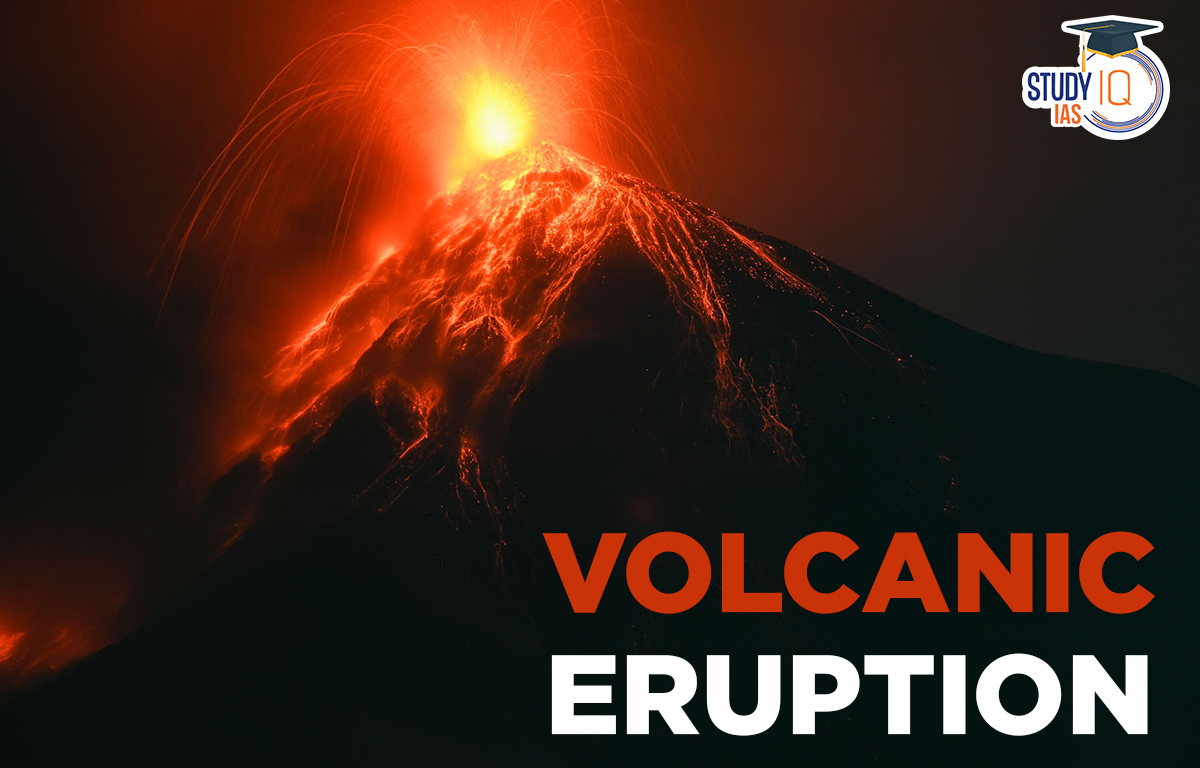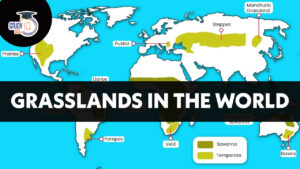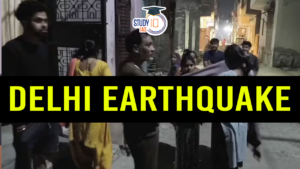Table of Contents
Context: Recently, Mount Etna in Italy erupted. On June 2, 2025, Europe’s most prolific volcano in Sicily, Mount Etna, erupted spectacularly, its largest since 2014. The eruption started at about 10:00 a.m. local time, caused by a partial collapse of the southeast crater, producing explosive activity that comprised lava fountains, pyroclastic flows, and a giant ash cloud shooting into the air about 6.5 kilometres.
What is a Volcanic Eruption?
A volcanic eruption is a natural phenomenon where magma (molten rock), gases, and ash are released from a volcano onto the Earth’s surface. This happens when pressure is generated in the Earth’s crust because of the movement of tectonic plates, pushing magma upwards through cracks and vents. The eruption can be explosive or effusive based on the composition and gas content of the magma. Pyroclastic and ash clouds are expelled by explosive eruptions, and lava flows by effusive eruptions. Volcanic eruptions can have a substantial influence on the environment, climate, and human habitations, but also produce fertile ground and new rock formations.
| Volcano |
| A volcano is an opening in the Earth’s crust where gases, ashes, and molten rock come out to the surface. It is also known as nature’s safety valve. The upper part of the Earth’s mantle is called the asthenosphere, which is a weaker area. This is where molten rock, called magma, rises up to the surface. When magma reaches the surface, it is known as lava. The materials that come out of a volcano include lava flows, ash, dust, and gases like sulfur, nitrogen, chlorine, hydrogen, and argon. |
Types of Volcanoes by Activity
There are mainly three types of volcanoes based on the frequency of eruption:
- Active: Currently erupting or likely to erupt (e.g., Mount Etna, Italy).
- Dormant: Not erupted recently but may erupt in future (e.g., Mount Fuji, Japan).
- Extinct: Unlikely to erupt again.
| Note |
|
About Volcanic Eruption Stages
Active Volcanoes: A volcano is called an active volcano if it erupts often. Its vent usually stays open. Some examples of active volcanoes are Mount Etna in Italy, Cotopaxi in Ecuador, and Ojos del Salado on the Argentina-Chile border, which is the highest active volcano in the world. Bareen Island is the only active volcano in the Andaman Sea.
Dormant Volcanoes: These volcanoes may not have erupted in recent years, but they could erupt again at any time. Examples include Mt. Vesuvius in Italy, Mt. Fuji in Japan, and Krakatoa in Indonesia.
Extinct Volcanoes: These volcanoes have not erupted in a very long time. Their vents are closed with solidified lava, and the craters may be filled with water, creating crater lakes. The slopes of these volcanoes may be covered with plants. Examples include Popa in Myanmar and Mt. Kenya in Eastern Africa.
Recent Examples of Volcanic Eruptions
- Mount Etna, Italy – Frequent eruptions (2021, 2023).
- La Palma, Canary Islands (Spain) – Major eruption in 2021, causing evacuations.
- Hunga Tonga, Tonga – Massive undersea eruption in Jan 2022, caused tsunamis across the Pacific.
- Mount Semeru, Indonesia – Erupted multiple times (2021–2023), deadly pyroclastic flows.
- Pinatubo, Philippines – Historic 1991 eruption, affected global temperatures.
Why do Volcanoes Erupt?
- Magma Formation: Deep inside the Earth, high temperature and pressure melt mantle rocks to form magma.
- Magma Ascent: Magma is less dense than solid rock, so it rises and accumulates in underground chambers.
- Volatile Compounds: Water vapour, CO₂, SO₂, and other gases dissolve in magma under pressure.
- Bubble Formation: Near the surface, pressure drops, gases escape, and form bubbles, increasing internal pressure.
- Pressure Release: Faults or tectonic boundaries allow pressure to escape, leading to violent eruptions.
- Bottlenecks: If magma is blocked, seismic activity increases as pressure builds.
Factors Causing Volcanic Eruption
The Earth’s mantle is divided into layers based on depth, ranging from 8 to 35 km for the upper mantle, 400 to 660 km for the transition zone, and 660 to 2,891 km for the lower mantle. As you go deeper, temperatures can reach up to 1,000°C, and pressure increases significantly. Three main factors cause volcanic eruptions:
- The buoyancy of the magma,
- Pressure from gases in the magma
- Rising pressure on the chamber’s lid.
Inside the Earth, magma often contains gases like carbon dioxide and hydrogen sulfide. These gases, along with water vapour, make the magma very explosive. The pressure from these gases pushes the magma out as lava when it reaches the surface.
When two tectonic plates push against each other or move apart, the area can become weak, and a volcano may erupt there. An example is the area between the African and Eurasian plates. During eruptions, a phenomenon called “Pele’s Tear” can occur.
Outcome of Volcanic Eruption
These are types of volcanoes and volcanic landforms formed due to volcanic activity, including eruptions and magma movement.
- Shield Volcanoes: Volcanoes are mostly made of basalt, which is a type of lava that flows easily when it erupts. They can be explosive if water enters the vent, but otherwise, they tend to be less explosive. The lava often shoots up like a fountain and builds up a cone at the top of the vent, forming a central cone, like those found in Hawaii.
- Composite Volcanoes: When a volcano erupts, it not only releases lava but also produces a lot of pyroclastic material and ashes. This material gathers around the vent opening, forming layers that give the mountain a cone shape, making them look like composite volcanoes. These types of volcanoes usually have explosive eruptions, like Mount Fuji in Japan.
- Caldera: These volcanoes are very explosive, and when they erupt, they often collapse inward instead of building up tall structures. The depressions that form after this collapse are called calderas.
- Flood Basalt Provinces: These volcanoes erupt very fluid lava that can flow over long distances. In some places around the world, this lava covers thousands of square kilometers, with some flows extending up to 100 km. An example of this is the Deccan Traps in Maharashtra, India.
- Mid-Ocean Ridge Volcanoes: These volcanoes are found in ocean areas, where there is a system of mid-ocean ridges that stretches over 70,000 km across all the ocean basins. The central part of these ridges experiences frequent eruptions.
- Volcanic Landforms: During volcanic eruptions, the lava that comes out cools down and turns into igneous rocks. This cooling can happen either on the surface or inside the Earth’s crust. There are two types of igneous rocks: volcanic rocks, which cool on the surface, and plutonic rocks, which cool inside the crust. The lava that cools inside the crust forms different shapes called intrusive forms. These are: Batholiths, Laccoliths, Lopoliths, Phacolites, sill or sheet and Dyks.
Impact of Volcanic Eruption
- Rocks are formed on the Earth’s surface when volcanoes erupt.
- Volcanic eruptions release gases and dust into the air, which can change the climate.
- Over millions of years, when there were many eruptions, volcanoes have also contributed to global warming by releasing greenhouse gases.
- Volcanoes are found in certain places, but the gases, dust, and ash from eruptions can spread far away.
- Eruptions in tropical areas can impact the climate in both the Northern and Southern Hemispheres because of how air moves. However, eruptions at mid or high latitudes mostly affect just the hemisphere where they occur.
Facts Related to Volcanic Eruption
- A volcano is a vent or fissure or a rupture in a planet’s crust, such as the one on Earth, that permits hot lava, volcanic ash, and gases to escape from a magma chamber below the surface.
- The term magma is used for molten rock that is underground, and lava for molten rock that breaks through the Earth’s surface.
- Magma has a temperature between 1300 and 2400 degrees.
- Compared to magma, lava has a lower temperature. The temperature spans 1300 to 2200 degrees Fahrenheit.
- The most recent volcanic eruption on the undersea volcano Hunga Tonga-Hunga Haapai, located in the Tongan archipelago in the southern Pacific Ocean, started on December 20, 2021. On January 15, 2022, approximately four weeks after the eruption’s initial start, it reached its largest and most intense peak.
|
Pacific Ring of Fire |
|


 Grasslands in the World, Map, Types and ...
Grasslands in the World, Map, Types and ...
 Places in News for UPSC 2025 for Prelims...
Places in News for UPSC 2025 for Prelims...
 Earthquake in Delhi: Causes, Impacts and...
Earthquake in Delhi: Causes, Impacts and...





















